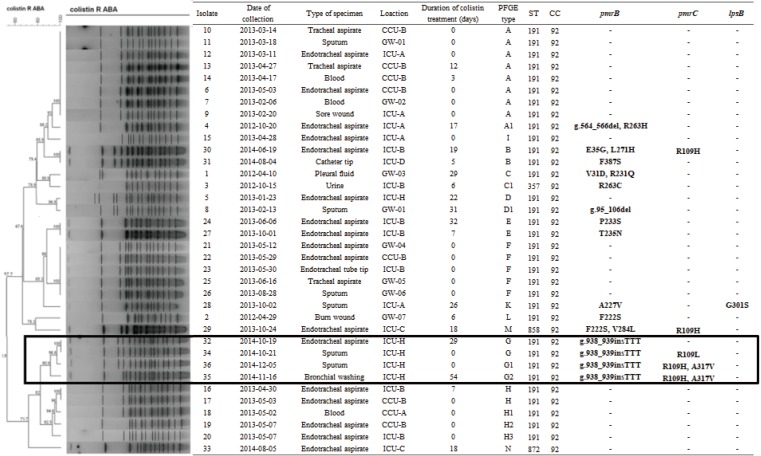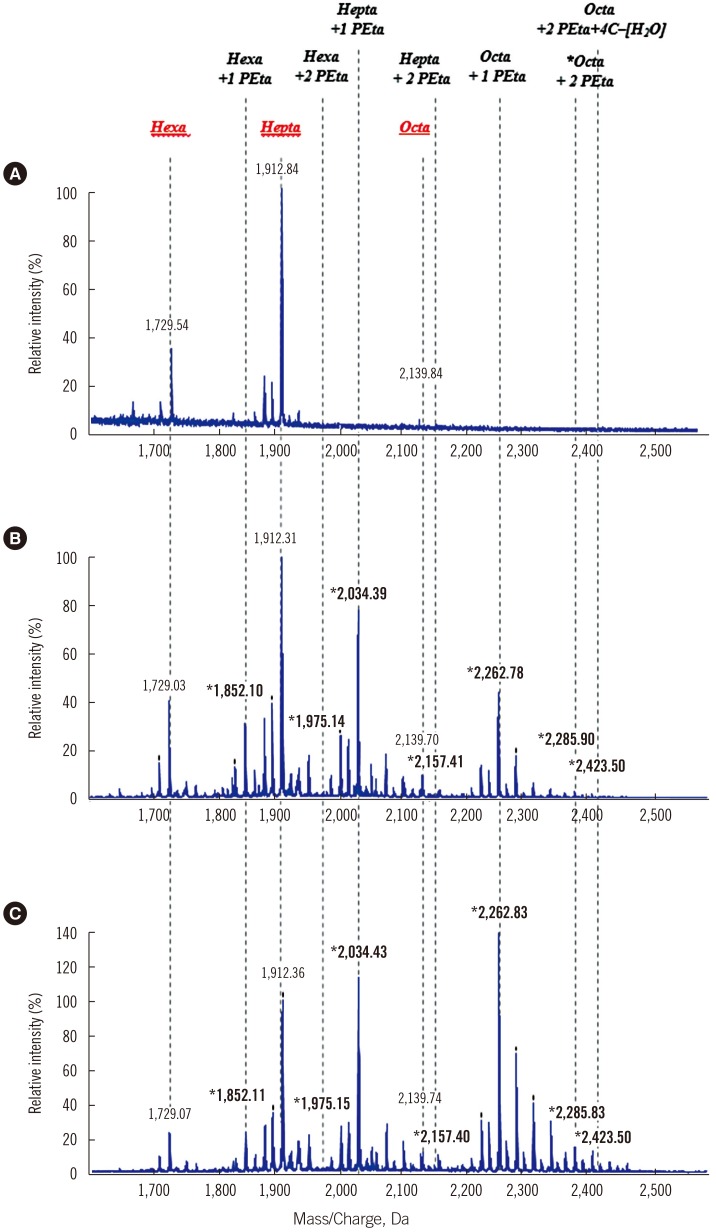Ann Lab Med.
2018 Nov;38(6):545-554. 10.3343/alm.2018.38.6.545.
Differences in Colistin-resistant Acinetobacter baumannii Clinical Isolates Between Patients With and Without Prior Colistin Treatment
- Affiliations
-
- 1Department of Laboratory Medicine, Yonsei University College of Medicine, Seoul, Korea.
- 2Department of Laboratory Medicine, Sheikh Khalifa Specialty Hospital, Ras Al Khaimah, UAE.
- 3Department of Laboratory Medicine and Research Institute of Bacterial Resistance, Yonsei University, Seoul, Korea. kscpjsh@yuhs.ac
- 4Brain Korea 21 PLUS Project for Medical Science, Yonsei University, Seoul, Korea.
- KMID: 2429120
- DOI: http://doi.org/10.3343/alm.2018.38.6.545
Abstract
- BACKGROUND
The increasing morbidity and mortality rates associated with Acinetobacter baumannii are due to the emergence of drug resistance and the limited treatment options. We compared characteristics of colistin-resistant Acinetobacter baumannii (CR-AB) clinical isolates recovered from patients with and without prior colistin treatment. We assessed whether prior colistin treatment affects the resistance mechanism of CR-AB isolates, mortality rates, and clinical characteristics. Additionally, a proper method for identifying CR-AB was determined.
METHODS
We collected 36 non-duplicate CR-AB clinical isolates resistant to colistin. Antimicrobial susceptibility testing, Sanger sequencing analysis, molecular typing, lipid A structure analysis, and in vitro synergy testing were performed. Eleven colistin-susceptible AB isolates were used as controls.
RESULTS
Despite no differences in clinical characteristics between patients with and without prior colistin treatment, resistance-causing genetic mutations were more frequent in isolates from colistin-treated patients. Distinct mutations were overlooked via the Sanger sequencing method, perhaps because of a masking effect by the colistin-susceptible AB subpopulation of CR-AB isolates lacking genetic mutations. However, modified lipid A analysis revealed colistin resistance peaks, despite the population heterogeneity, and peak levels were significantly different between the groups.
CONCLUSIONS
Although prior colistin use did not induce clinical or susceptibility differences, we demonstrated that identification of CR-AB by sequencing is insufficient. We propose that population heterogeneity has a masking effect, especially in colistin non-treated patients; therefore, accurate testing methods reflecting physiological alterations of the bacteria, such as phosphoethanolamine-modified lipid A identification by matrix-assisted laser desorption ionization-time of flight, should be employed.
Keyword
MeSH Terms
Figure
Reference
-
1. Agodi A, Voulgari E, Barchitta M, Quattrocchi A, Bellocchi P, Poulou A, et al. Spread of a carbapenem- and colistin-resistant Acinetobacter baumannii ST2 clonal strain causing outbreaks in two Sicilian hospitals. J Hosp Infect. 2014; 86:260–266. PMID: 24680473.2. Cai Y, Chai D, Wang R, Liang B, Bai N. Colistin resistance of Acinetobacter baumannii: clinical reports, mechanisms and antimicrobial strategies. J Antimicrob Chemother. 2012; 67:1607–1615. PMID: 22441575.3. Li J, Rayner CR, Nation RL, Owen RJ, Spelman D, Tan KE, et al. Heteroresistance to colistin in multidrug-resistant Acinetobacter baumannii. Antimicrob Agents Chemother. 2006; 50:2946–2950. PMID: 16940086.4. Peleg AY, Hooper DC. Hospital-acquired infections due to Gram-negative bacteria. N Engl J Med. 2010; 362:1804–1813. PMID: 20463340.5. Amudhan SM, Sekar U, Arunagiri K, Sekar B. OXA beta-lactamase-mediated carbapenem resistance in Acinetobacter baumannii. Indian J Med Microbiol. 2011; 29:269–274. PMID: 21860108.6. Evans BA, Amyes SG. OXA beta-lactamases. Clin Microbiol Rev. 2014; 27:241–263. PMID: 24696435.7. Karaiskos I, Galani L, Baziaka F, Giamarellou H. Intraventricular and intrathecal colistin as the last therapeutic resort for the treatment of multi-drug-resistant and extensively drug-resistant Acinetobacter baumannii ventriculitis and meningitis: a literature review. Int J Antimicrob Agents. 2013; 41:499–508. PMID: 23507414.8. Nation RL, Li J. Colistin in the 21st century. Curr Opin Infect Dis. 2009; 22:535–543. PMID: 19797945.9. Newton BA. The properties and mode of action of the polymyxins. Bacteriol Rev. 1956; 20:14–27. PMID: 13303920.10. Schindler M, Osborn MJ. Interaction of divalent cations and polymyxin B with lipopolysaccharide. Biochemistry. 1979; 18:4425–4430. PMID: 226126.11. Falagas ME, Rafailidis PI, Matthaiou DK. Resistance to polymyxins: Mechanisms, frequency and treatment options. Drug Resist Updat. 2010; 13:132–138. PMID: 20843473.12. Koch-Weser J, Sidel VW, Federman EB, Kanarek P, Finer DC, Eaton AE. Adverse effects of sodium colistimethate. Manifestations and specific reaction rates during 317 courses of therapy. Ann Intern Med. 1970; 72:857–868. PMID: 5448745.13. Meletis G, Tzampaz E, Sianou E, Tzavaras I, Sofianou D. Colistin heteroresistance in carbapenemase-producing Klebsiella pneumoniae. J Antimicrob Chemother. 2011; 66:946–947. PMID: 21393203.14. Pournaras S, Ikonomidis A, Markogiannakis A, Spanakis N, Maniatis AN, Tsakris A. Characterization of clinical isolates of Pseudomonas aeruginosa heterogeneously resistant to carbapenems. J Med Microbiol. 2007; 56:66–70. PMID: 17172519.15. Yau W, Owen RJ, Poudyal A, Bell JM, Turnidge JD, Yu HH, et al. Colistin hetero-resistance in multidrug-resistant Acinetobacter baumannii clinical isolates from the Western Pacific region in the SENTRY antimicrobial surveillance programme. J Infect. 2009; 58:138–144. PMID: 19058855.16. Hood MI, Becker KW, Roux CM, Dunman PM, Skaar EP. Genetic determinants of intrinsic colistin tolerance in Acinetobacter baumannii. Infect Immun. 2013; 81:542–551. PMID: 23230287.17. Moffatt JH, Harper M, Harrison P, Hale JD, Vinogradov E, Seemann T, et al. Colistin resistance in Acinetobacter baumannii is mediated by complete loss of lipopolysaccharide production. Antimicrob Agents Chemother. 2010; 54:4971–4977. PMID: 20855724.18. Adams MD, Nickel GC, Bajaksouzian S, Lavender H, Murthy AR, Jacobs MR, et al. Resistance to colistin in Acinetobacter baumannii associated with mutations in the PmrAB two-component system. Antimicrob Agents Chemother. 2009; 53:3628–3634. PMID: 19528270.19. Lee H, Hsu FF, Turk J, Groisman EA. The PmrA-regulated pmrC gene mediates phosphoethanolamine modification of lipid A and polymyxin resistance in Salmonella enterica. J Bacteriol. 2004; 186:4124–4133. PMID: 15205413.20. Liu YY, Wang Y, Walsh TR, Yi LX, Zhang R, Spencer J, et al. Emergence of plasmid-mediated colistin resistance mechanism MCR-1 in animals and human beings in China: a microbiological and molecular biological study. Lancet Infect Dis. 2016; 16:161–168. PMID: 26603172.21. Kim Y, Bae IK, Lee H, Jeong SH, Yong D, Lee K. In vivo emergence of colistin resistance in Acinetobacter baumannii clinical isolates of sequence type 357 during colistin treatment. Diagn Microbiol Infect Dis. 2014; 79:362–366. PMID: 24809861.22. Beceiro A, Moreno A, Fernandez N, Vallejo JA, Aranda J, Adler B, et al. Biological cost of different mechanisms of colistin resistance and their impact on virulence in Acinetobacter baumannii. Antimicrob Agents Chemother. 2014; 58:518–526. PMID: 24189257.23. Hraiech S, Roch A, Lepidi H, Atieh T, Audoly G, Rolain JM, et al. Impaired virulence and fitness of a colistin-resistant clinical isolate of Acinetobacter baumannii in a rat model of pneumonia. Antimicrob Agents Chemother. 2013; 57:5120–5121. PMID: 23836181.24. López-Rojas R, McConnell MJ, Jiménez-Mejías ME, Domínguez-Herrera J, Fernández-Cuenca F, Pachón J. Colistin resistance in a clinical Acinetobacter baumannii strain appearing after colistin treatment: effect on virulence and bacterial fitness. Antimicrob Agents Chemother. 2013; 57:4587–4589. PMID: 23836165.25. Jones CL, Singh SS, Alamneh Y, Casella LG, Ernst RK, Lesho EP, et al. In vivo fitness adaptations of colistin-resistant Acinetobacter baumannii isolates to oxidative stress. Antimicrob Agents Chemother. 2017; 61.26. López-Rojas R, Domínguez-Herrera J, McConnell MJ, Docobo-Peréz F, Smani Y, Fernández-Reyes M, et al. Impaired virulence and in vivo fitness of colistin-resistant Acinetobacter baumannii. J Infect Dis. 2011; 203:545–548. PMID: 21216865.27. CLSI. Performance standards for antimicrobial susceptibility testing. 26th ed. Wayne, PA: Clinical and Laboratory Standards Institute;2016. CLSI supplement M100-S26.28. EUCAST. Recommendations for MIC determination of colistin (polymyxin E) as recommended by the joint CLSI-EUCAST Polymyxin Breakpoints Working Group. Updated on Mar 2016. http://www.eucast.org/fileadmin/src/media/PDFs/EUCAST_files/General_documents/Recommendations_for_MIC_determination_of_colistin_March_2016.pdf.29. Orhan G, Bayram A, Zer Y, Balci I. Synergy Tests by E Test and checkerboard methods of antimicrobial combinations against Brucella melitensis. J Clin Microbiol. 2005; 43:140–143. PMID: 15634962.30. Woodford N, Ellington MJ, Coelho JM, Turton JF, Ward ME, Brown S, et al. Multiplex PCR for genes encoding prevalent OXA carbapenemases in Acinetobacter spp. Int J Antimicrob Agents. 2006; 27:351–353. PMID: 16564159.31. Cicek AC, Saral A, Iraz M, Ceylan A, Duzgun AO, Peleg AY, et al. OXA- and GES-type beta-lactamases predominate in extensively drug-resistant Acinetobacter baumannii isolates from a Turkish University Hospital. Clin Microbiol Infect. 2014; 20:410–415. PMID: 23957892.32. Segal H, Garny S, Elisha BG. Is IS(ABA-1) customized for Acinetobacter? FEMS Microbiol Lett. 2005; 243:425–429. PMID: 15686845.33. Beceiro A, Llobet E, Aranda J, Bengoechea JA, Doumith M, Hornsey M, et al. Phosphoethanolamine modification of lipid A in colistin-resistant variants of Acinetobacter baumannii mediated by the pmrAB two-component regulatory system. Antimicrob Agents Chemother. 2011; 55:3370–3379. PMID: 21576434.34. Tenover FC, Arbeit RD, Goering RV, Mickelsen PA, Murray BE, Persing DH, et al. Interpreting chromosomal DNA restriction patterns produced by pulsed-field gel electrophoresis: criteria for bacterial strain typing. J Clin Microbiol. 1995; 33:2233–2239. PMID: 7494007.35. Pittet D, Tarara D, Wenzel RP. Nosocomial bloodstream infection in critically ill patients. Excess length of stay, extra costs, and attributable mortality. JAMA. 1994; 271:1598–1601. PMID: 8182812.36. Hawley JS, Murray CK, Jorgensen JH. Colistin heteroresistance in Acinetobacter and its association with previous colistin therapy. Antimicrob Agents Chemother. 2008; 52:351–352. PMID: 17954699.37. Moosavian M, Shoja S, Nashibi R, Ebrahimi N, Tabatabaiefar MA, Rostami S, et al. Post neurosurgical meningitis due to colistin heteroresistant Acinetobacter baumannii. Jundishapur J Microbiol. 2014; 7:e12287. PMID: 25632326.38. Eilertson B, Maruri F, Blackman A, Herrera M, Samuels DC, Sterling TR. High proportion of heteroresistance in gyrA and gyrB in fluoroquinolone-resistant Mycobacterium tuberculosis clinical isolates. Antimicrob Agents Chemother. 2014; 58:3270–3275. PMID: 24687490.39. Pholwat S, Stroup S, Foongladda S, Houpt E. Digital PCR to detect and quantify heteroresistance in drug resistant Mycobacterium tuberculosis. PLoS One. 2013; 8:e57238. PMID: 23468945.40. Rohlin A, Wernersson J, Engwall Y, Wiklund L, Bjork J, Nordling M. Parallel sequencing used in detection of mosaic mutations: comparison with four diagnostic DNA screening techniques. Hum Mutat. 2009; 30:1012–1020. PMID: 19347965.
- Full Text Links
- Actions
-
Cited
- CITED
-
- Close
- Share
- Similar articles
-
- Successful Treatment of Acinetobacter Baumannii Meningitis with Colistin
- Discordance in Colistin Susceptibility Test for Acinetobacter baumannii Showing Resistance: MicroScan versus Etest
- Susceptibility of Clinical Isolates of Acinetobacter baumannii and Pseudomonas aeruginosa to Colistin and Polymyxin B in Korea
- Colistin, Hot Potato for the Therapy of Carbapenem-resistant Acinetobacter baumannii infections
- Risk factors associated with colistin-resistant Acinetobacter baumannii infection



